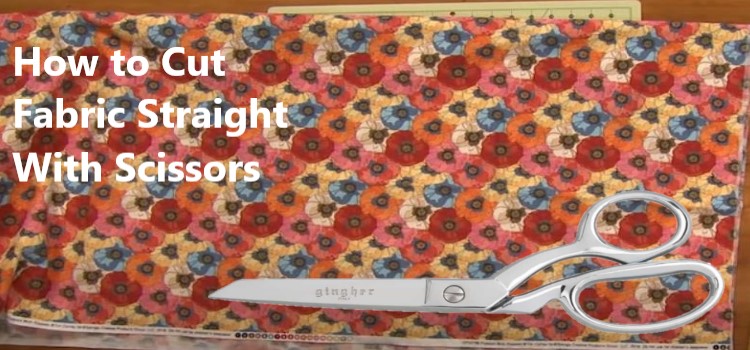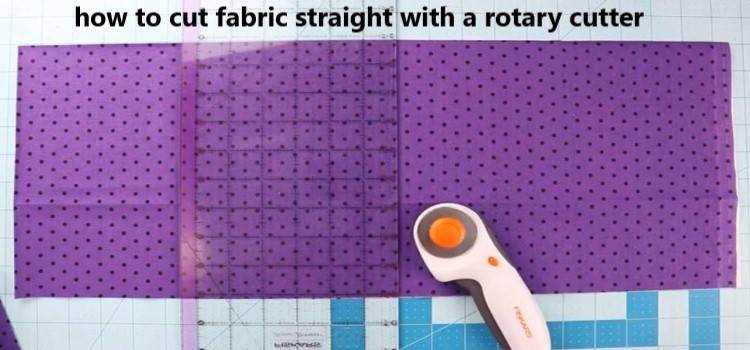You tried to cut a piece of fabric, and you haven’t messed up! Can you swear and claim that? Everyone with even a little bit of experience with sewing, cutting, and crafting can relate to this.
You also must have been worried to hell thinking about how to cut fabric straight. And why is it so challenging? You’re not alone in that, YNWA. (Any Liverpool fans out there?)

Are you buying pre-cut pieces of fabric for the crafting projects or your clothes? If yes, then good! If not, then you have to deal with this stuff. Getting that straight edge is vital.
Since you’re here, I assume you’re either struggling with it or looking for some tricks and tips regarding the topic in question. I wouldn’t say I’m the master of cutting, but I’ve got a few tricks up my sleeve that might just make your life easy.
Here are some of my techniques to achieve a perfectly straight fabric edge.
Table of Contents
Get to Know Your Fabric
The first mistake while trying to cut a piece of fabric is not using the proper technique for a specific fabric. How will you cut through with the scissors if you don’t know how the fabric will react?
I mean, different fabrics cut differently depending on the smoothness of the surface and fiber visibility. The smoother a fabric is, the harder it is to get a straight edge.
A piece of cotton fabric will cut drastically differently compared to a piece of silk fabric. It’s the same with Linen, Chiffon, Georgette, Polyester, Satin, etc.
These fabrics don’t have the same features in terms of smoothness, thickness, and roughness. And that’s going to require a lot of getting to know.
You might ask, isn’t a smoother fabric easier to cut? To that, I say, Yes! And that’s exactly why it’s harder to get a hold of the scissors and cut it with precision. When the fabric is rough and stiff, you can control the movement of the fabric better.
Therefore, become intimate with the fabric and notice how it reacts against it. The smoother the fabric, the more skillful you need to be.
Different Methods to Cut Fabric Straight
You might have thought there is only one way of cutting fabrics. But that’s old news. Now, you have the option to choose from various cutting tools to ease your crafting projects.
There are two main options you can opt for when cutting a piece of fabric. One is the scissors, and the other is the rotary cutter.
If you don’t have any experience with either, then do not worry a bit. Below, I’ll explain how to go about cutting fabric with both in simple steps.
Method 1: How to Cut Fabric Straight with Scissors?

Follow these steps if you’re going to use scissors,
Step 1: Prepping
Making preparations yourself and preparing the fabric itself both are vital. Since fabric tends to shrink to a degree, prewashing the fabric can save from a lot of trouble afterward. Depending on the fabric, the shrinkage can be up to 15%!
You don’t want to end with pieces of fabric that are too small for the project you’re attempting. So wash and iron the fabric.
Step 2: Cutting Surfaces
To maintain high precision while cutting the fabric, it’s necessary to ensure that the surface is stable and flat enough to cut with control. A flat surface is your best friend. Having a flat and hard surface with a distinct edge can help a lot. You can use the edge of the table to guide your scissors in a straight line.
If you keep the edges of the fabric over the edge of the table, it will prevent the fabric from being pulled and dragged mistakenly.
Step 3: The Right Tools for the Job
You’ve decided that you’re going to use scissors to do the job. I don’t care about the brand. Just grab a sharp pair of scissors, and make sure that the scissors are on the thinner side. Trust me on this one. It’s going to make a lot of difference when cutting.
Also, you’re going to need a 90-degree angle for squaring up the fabric edges.
Step 4: Find a Straight Edge
You’ve got your scissors beside you and your fabric in front. Now take your fabric and find its straight edge. If you’ve bought it as a separate piece from a bigger fabric, it should have already had an edge cut by the store.
In case you’re working with a large fabric wheel, it will have an edge with the brand’s/manufacturer’s name and a few holes.
This straight edge is your guide if you don’t have a scale. Follow this straight edge to cut the fabric.
Step 5: Find the Crosswise Grain
The fabric has two edges. One is parallel to the crosswise grain, and the other is along the lengthwise grain. The second one is called ‘Selvage.’ It’s the uncut edge of the fabric. You’re going to work on both of them.
Step 6: Cut off the Selvage
This one is the easier one since you have a line of reference. Cut the selvage in a straight line. Follow the selvage and keep the same distance. It should be done in a jiffy.
Step 7: Square Up
I find this a pretty neat technique since you’re using a 90-degree angle of reference. Messing it up is hard even if you try.
If you don’t have a 90-degree angle with you, you can use a square table’s corner as a reference.
You’re all set to get the perfect edge.
On to the next one!
Read Next: Guide on Sharpening Fabric Scissors
Method 2: Cutting Fabric Straight with a Rotary Cutter
I think rotary cutters are second to scissors for getting a perfect edge. It has become quite the popular option for some reason.
Although it’s a type of machine, it still requires a good bit of skill and a few extra tools to work with it.

Besides, a rotary cutter is a professional tool that needs a dedicated workspace. Not many can afford to do that.
Required Tools for Rotary Cutter
You need two tools besides a rotary cutter: a good ruler and a self-healing mat. I used a transparent ruler, and it helped a lot thanks to increased visibility.
Additional tools
Before you think that I’m making things complicated, hear me out! Having a few fabric weights and a protective glove will make things a lot simpler.
The weights will keep the fabric in place, and the protective glove will protect your hands from getting cut during a swift cutting motion.
Rotary Cutter Size
If you’ve already chosen a rotary cutter, then go to the next step. Otherwise, get a 45mm rotary cutter, which is recommended for most projects.
Now, follow the same steps as the previous scissor method. Make sure to incorporate the extra tools and the additional tools. You’ll thank me later.
Few Tips for Cutting Fabric Straight
Practice makes everyone perfect. Nah, that’s a lie. If you learn from your past mistakes, that’ll make you perfect. Remember that when you cut your fabric.
Here are a few pointers that might help you.
- Cut and Rip: If you’re like me, sometimes you might not care if you get an untidy and frayed edge. In that case, just use the cut-and-rip technique. However, it won’t work with all fabric since it’s easy to disfigure the fabric if it’s too light or structurally weak. It works best only with woven fabrics.
- Diagonal Fold: This is a good technique and an alternative to using a 90-degree angle. It’s hard to illustrate with words, so bear with me. As the fabric lay on the table, take its bottom right corner, and diagonally fold it to match the opposite top corner. Then, take the left corner and do the same. Now, the selvage will lie along the top of the fabric. You can use this technique to get perfect strips.
- T-Square: T-ruler or T-square is a common ruler among designer professionals. If you have this ruler, it’ll assist you in cutting the long piece of fabric. You don’t need to measure a couple of times to cover the whole length. It’ll also help you to cut angled straight lines.
- Ruler and Mat in a Line: Does your cutting mat have grid markings? If it’s a yes, always use a transparent ruler to align with the mat. I won’t go into details with this one. You’ll know what to do when you see it. It makes the fabric-cutting process so much easier and faster since you don’t have to worry about getting it wrong.
Last Piece of Advice
As a beginner, messing up is easy as you don’t properly know the right way to cut fabric straight. Even professionals can mess up. If you mess up, the piece of fabric becomes unusable for the specific project.
So, I’ve always marked a bit more extra length and width. That way, you can salvage the fabric even if you mess up! Add a few inches extra with the required measurement.
